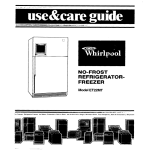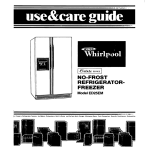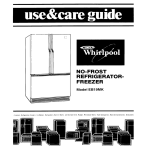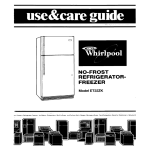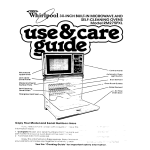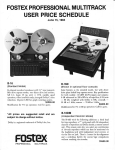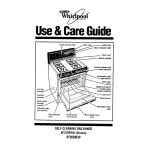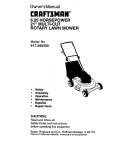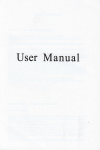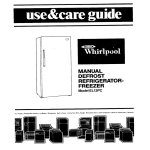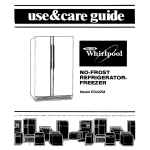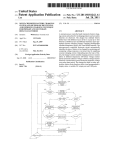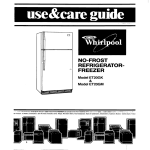Download NO-FROST REFRIGERATOR- FREEZER
Transcript
NO-FROST REFRIGERATORFREEZER Model ET22MT , Freezers Refrigerator-Freezers Ice Makers DIshwashers. Bullt-ln Ovens and Surface Units Ranges Microwave Ovens Trash Compactors. Room Air Conditioners. Dehumldille Please read this Use and Care Guide before you do anything else... This booklet tells you how to start your refrigerator, clean it, move shelves and adjust controls. It even tells you what new sounds to expect from your refrigerator. Treat your new refrigerator with care. Use it only to do what home refrigerators are designed to do. Parts and features Automatic /I’ Ice Maker Power Saving Control (not shown] Temperature Control ) I Air Control < Meat Pan with Cold Control Adjustable Glass Shelves f-Crispers with Humidity Control \ I Copy your Model and Serial Numbers here... 1 I I I 2 When vou need service or call with a auestlon have this’lnformatlon ready: 1. Complete Model and Serial Numbers [from the label located CISshown). 2. Purchase date from sales slop. Copy this information in these spaces Keep this book, your warranty and sales slip together in a handv olace Pleb’se complete and mail the Owner Registration card furnished with this product. Model Number Serial Number Purchase Service Dote Company and Telephone Number *TMK. Contents SAFETY FIRST BEFORE YOU PLUG IT IN Install Properly Level Refrrgerator-Freezer Remove Soles Labels : Clean It. Plug It In USING YOUR REFRIGERATOR Setting the Controls Changing the Control Settings : Power Savrng Control Adjusting Meat Pan Temperature Adjusting Crisper Humidity Control Adjusting the Refrigerator Shelves Removing the Crispers and Covers Moving the Meat Pan Page 3 3 4 4 4 4 4 5 5 5 5 6 6 6 6 ? Tilt Ice. Dispenser. Removing the Base Griile : : Changing theLight Bulbs Sounds You May Hear Energy Saving Tips CLEANING YOUR REFRIGERATGR Cleaning Chart, FOOD STORAGEGUIDE : : : :, Storing Fresh Food Storing Frozen Food :: :: : VACATION AND MOVING CARE IF YOU NEED SERVICE OR ASSISTANCE I. Before Calling for Assistance 2. If You Need Assistance 3 If You NeedServIce 4. If You Havea Problem Page 7 7 8 8 8 8 9 10 10 11 14 15 15 15 15 15 c 1986 Whrrlpool “,orporatton Before you plug it in IMPORTANT Before using Your refrigerator, you are personallv responsible for making sure that It l IS installed and leveled on a floor that tillI hold the weight, and in an area surtable for Its size and use. l ISconnected only to the right kind of outlet with the rrght electrical supply and grounding (Refer to Your “Electrical Requirements and Groundrng Instructions”) l IS used only for jobs expected of home re frigerators. s not near on oven, radiator (or other heat source. IS properly maintainec =I l IS out of the weather l ISused in an area where the room terr not fall below 55’ F (I:3= C]. . ISnot used by those who may not understand how it should be used. l IS not loaded with foeId before it has time to get properly cold l l Install properly.. Remove sales labels.. . . Remove the Consumer Buy Guide label, tape and any inside iabels before using the refrigerator. To remove any remaining glue: 1 Rub briskly with thumb to make a ball then remove OR 2 Soak area with dIshwashIng detergent solution [I teaspoon detergent in 1 quart warm water] before removing glue as described in step 1 DO NOT USE rubbing alcohol or flammable or toxic solvents, such as acetone, gasoline, carbon tetrachloride, etc. These can damage the material. NOTE: DO NOT REMOVE ANY PERMANENT INSTRUCTION LABELS INSIDE YOUR REFRIGERATOR. Do not remove the Tech Sheet fastened under the refrigerator at the tront. y-=pL1,jrl 111 II- i Clean it.. . Clean your refrigerator before using It See cleaning instructions cn page 8 1 Allow % Inch (125 cm] space on each side ana tit the top of the refrigerator for ease of ~nstallat~or, 2 If the refrigerator ISto be against a wall, VOL might want to leave extra space so the door car- De opened wider 3 The refrigerator back can be flush agalrst ihe WCII Plug it in... 3-prong grounding type wall receptacle, Level refrigerator-freezer.. Levelling SK4 . ( Use Screwdrlver ng Plug Refrigerator Power Cord RECOMMENDED Right to Raise. Left to Lower 1 2. 3 4. Remove base grille [see page 7) To raise front, turn each screw to the rlgnt. To lower front, turn each screw to the left Check with level GROUNDING METHOD A ‘15 Volt 60 tlz AC only 15 or 20 ampere fused C:IIC properly grounaed electrical supply is reaclired It is recommended that a separate circuit serving orlly this appliance be provided Do not use an extension cord. Use a receptacle which cannot be turned off with a switch or pull chain. See lndlvldual electrical requlreIr’er% and grounding InstructIon sheet lr your literc:x’c- r?ackgge Using your refrigerator Power Saving Setting Control Temperature the controls.. Air Outlet Control . Controls for the refrigerator and freezer ore lrl t7e ,efrlgerator When the refrigerator IS plugged or’ for tble !lrst time ‘13’ tne TEMPERA CONTROL to 3 “JR~ Changing 2 Set tt-e AIR COY TROL ‘o B the control settings.. Give the refrigerator pletely before addlng eral hours ) These settings should be about right for normal household refrigerator usage. The controls will be set about right when milk or .xe IS as cold as you llke and when ice cream firm Do not block the air outlet on the control panel. ->locklng It can slow the air movement needed to seep temperatures at the level you set Adjust the Temperature Control first Walt at least 24 hours between adjustments * Then adlust the Air Control, If needed. l l tAl:)w REASONS: Door opened 1after, Large amount .,f food added Room temperature too warm Goor opened often 1arge amount ‘:!f food added Ley colU roonl temperature [cart cycle oflen enough) 5r’rol: not set correctly fix hour condlt Ins QUESTIONS? :all your If Refrigero+?r 3oL-L’NE ” Section IS .-?r,, ce TOO COLL. issit,tance If ICE Isn’t 1+ephone MADE FAST ENOclGH .c 3er ,~0 je 15; If BOTI SEC’IONS are TCj3 WARM Power Saving Control.. heavy time to cool down comfood. (This may take sev- . If you need to adjust temperatures In the refrlger:ltor or freezer, use the settings ltsted In the chart CONDITION : If Refrigerator Section IS TOO WARV If Freezer SectIon IS TOO WARL’ Air Control ice ‘JSCIge J/e9 cold roon temperature ican’t cycle often enough) Zoor opened often ,arge amount ‘.,f food added ‘tier;, wurm or very cold room temperatures RECOMMENDED SETTINGS: 4 Temperature Control C Air Control Temperature Air Control Control 4 A Temperature Air Control Control 2 B Temperature Air Control Control 3 A Temperature Air Control Control 4 B . The Power Saving Control ov the Cor~‘-;:l C, lr ile operates electric heater around the door opera gs These heaters help eeep moisture fror’ fxrr ‘79 *~-~eoutside of the refr gerctor ‘!se the OFF set* ng dher; ?umldlty , 0h 2 Use the “ON”settlng If moisture forms on the outside of the refrigerator Adjusting meat pan temperature.. Cold 4 1 1 1 I~1~~~ . b Coldest Cold arr flows Into the meat pan container through an openrng in the back of the refrigerator. Thus helps keep the meat pan colder than the rest of the refrigerator Set the control to let rnae or less cold arr through Adjusting crisper Humidity Control... You can control the amount of ture-sealed crisper 1 The control can be adjusted tween LO and HI 3. 2 LO [open] lets morst air out of crrsper for best storage of fruits and vegetables wrth skins Adjusting humrdrty in the mois to any settrng be HI (closed] keeps morst arr in the crls per for best storage of fresh leafy vege~ tables. shelves.. . Shelves can be adjusted to match the way you use your refrigerator. Glass shelves are strong enough to hold bottles, mrlk and other heavy food items G/ass shelves To remove glass shelves: 1. Tilt up at front. 2 Lift up at back. 3 Pull shelf straight out To replace: 1. Guide the rear hooks into the slots In the shelf supports 2 Tilt up front of shelf until hooks drop Into slot Lower front of shelf to level position are heavy Be careful To remove door shelves: l Lift up and out To replace: 1 Insert hooks Into guides on both sides 2 Push down. Removing the crispers Removing crispers: 1 Slide crispers straight out to stop 2 Lift the front. 3 Slide the rest of the way out 4 Replace in reverse order and crisper covers... I Push the lab to Clear the Cover. To remove the covers: Covers are held In place by two p)egs at the bat and two notched tabs In front 1 Press front tabs out of the way 2 Lift cover front 3 Lift back off the pegs 4 Replace in reverse order l 6 If necessary, the center leg can be made shorter or longer to help level the crisper covers Turn the leg clockwIse to make It longer.Turn the leg counterclockwise to shorten it. Removing the meat pan... Turn the control to COLD to avoid overcooling food items In the refrigerator section while the meat pan IS removed. The meat pan, shelf and container carI be rep moved for cleaning. When it is replaced, it must always be in the same position. ’ Slmde meat pan out & TI t shelf up at front Pull straight out i LIY meat pan container :, i~ft up at the back ! Pt,Ii straight out Using automatic up at front ice maker W J To replace (The meat pan container must be placed in the same position): ’ Position container so that opening fits over cold arr Inlet Guide rear hooks Into slots In shelf supports Tilt up front of container until hooks drop into slot. Lower conturner to level position Replace shelf over container Slrde meat pan back into container . Reset meat pan temperature control to desired sethng. and Tilt Ice” Dispenser.. Tnere are a few thongs you 11want to know about -r’e Ice bin ana the automatic ice maker tha. fills it l B/n IS rnsrde small door or1 freezer door l To open Tilt-Ice’ Dispenser Door 11ft up on handle tilt door down. l Reach in, pull brn out part way or remove ii from freezer l If you remove cxn STOP ice maker Open freezer door and push iever to OFF, Push It back ON when you replace bin ON /OFF Lever is . You WI/I hear water filling the mold and Ice cubes Into the brn These are normal sounds. l The Ice maker WIII stop automatrcally when the brn IS full It ~111start again when you remove ice. * Shake bin occasIonally to keep cubes separated. l faiiing Ips: New plumbing connections can give the first cubes an odd taste cr color. Just throw these away. The ice maker will refill the bin. 0 Cubes stored too long may develop an offflavcr...like stale water. Throw them away. l Cubes stored for more than a few weeks will become smaller because moving air in the freezer is so coid that it starts a slow evaporation. If you use ice often, you may never notice shrinkage. l Good water quality is important for good ice quality It is not recommended that the ice maker be connected to a softened water supply. Water softener chemicals such as salt from a malfunctioning softener can damage the ice maker mold and lead to pcor quality ice. If a softened water supply cannot be avoided., then it is important that the water softener be well maintained and operating properly, l Removing the base grille... Support L pull grille outwards as shobr~, ( Do not remove Tech sheet faster ~>ab6.F ‘1 J’ ‘c To replace: ,_I:le up grille support tabs wrth metal CIIPS F.,sh firmly tc snap into place 55 ‘k ao[ors TMK Tabs Changing the light bulbs... WARNING: Before removing the light shield for cleaning or for replacing the bulb, either unplug refrigerator or disconnect electricity leading to refrigerator at the main power supply. Shock and injury can occur if electriclty remains connected. Push in the Center; Pull Down. light bulb behind light shield: 1 Push lrghtly on the top center of the light shield until the notched tab unhooks from the control panel 2 Pull down on the shreld until the tab clears the con trol panel 3 Lift the back hooks out of their slots 4 Replace with a 40.watt applrance bulb 5 Replace light shreld In reverse order light bulb behind ice maker: 1 Remove the ice brn [see ice maker instructlons page 7 1 2 Replace with a 40-watt appliance bulb 3 Replace ice bin light bulb behind crispers: 1 Remove crispers and crisper covers 2 Bulb ISon back wall of refrigerator 3 Replace with a 40-watt appliance bulb 4 Replace crisper and crisper cover 5 Plug in the refrigerator. / Sounds you may hear.. . ‘5 P 3’ ,+ Possible Sounds: Slight Hum, Soft Hiss: Clicking Sounds: or Snapping Water Sounds: l l Your new refrigerator may make sounds that your old one didn’t. Because the sounds are new to you, you might be concerned about them. Don’t be Most of the new sounds are normal Hard surfaces like the floor, walls and cabtnets can make the sounds seem louder The following chart describes the kinds of sounds that might be new to you, and what may be making them. Probable Causes: You may hear the refrigerator’s fan motor and moving arr The defrost timer makes a definite click when the refrigerator also makes a sound when the refrigerator starts. stops running. It When the refrigerator stops running, you may hear gurgling in the tubing for a few minutes after It stoos You may also hear defrost water running into the defrost water pan. Ice Maker Sounds: -trickling water -thud [clatter of ice) You may hear buzzing [from the water valve], trrcklrng water and the clatter of ice dumped into the bin Running Your refrigerator has a hrgh-efficiency compressor and motor. It will run longer than older designs. It may even seem to run most of the time. Sounds: Energy saving tips... You can help your refrigerator use less electricity l Check door gaskets for a tight seal Level the cabInet to be sure of a good seal l Clean the condenser COI! regularly l Open the door as few times as possible Th,lnk abait what you need before you open the door Get everything out at one time Keep foods organrzed so you won’t have to search for what you want Close door as soon as food IS removed l Go ahead and fill up the refrigerator, but doh t overt crowd It so air movement IS blocked l l l ITIS a waste of electricity to set the refrigerator and freezer to temperatures colder than they need to be If Ice cream IS firm in the freezer and drinks are as cold as your family likes them, that’s cold enough. Keep the Power Saving Control on OFF unless moisture forms on the refrigerator exterior Make sure your refrigerator is not next to a heat source such as a range, water heater, furnace, radiator. or in direct sunlight Cleaning your refrigerator Both the refrigerator and freezer sections defrosi automatrcally But both should be cleaned about once a month to help prevent oaors from building JC c)f course spills should be wiped ur rlah+ cjwa’~ 8 -0 clean your refrigerator, turn the Temperature Control to OFF, unplug It, take out all removable parts, ar*d clean it according to the followlng li~rec+~ons Cleaning chart... How to clean Part What to use Removable parts (shelves, crisper, meat pan etc ) Sponge or cloth; mild detergent and warm water, Wash removable ports wrth warm water and CI mild detergent Rinse and dry Outsrde Sponge, cloth or paper towel, mrld detergert applrance wax (or goi :3 uuto paste wax] Wash wrth warm water and a mild detergent Do not use abrasive or harsh cleansers. Rrnse and dry Wax panted metal surfaces at least twice a year with appliance wax or a good auto paste wax Apply wax with a clean, soft cloth. Do not use wax on plastic parts. Waxing lnslde walls [Freezer should be allowed to warm up so cloth won’t strck ) painted metal Sponge, soft cloth or paper towel, baking soda, warm water, m11c detergent surfaces Sponge, sot* cloth or paper towel, mild detergent, ;Yarm water DO NOT USE Cleaning bleaches or cleansers Dark plastics (covers and panels] Mrld detergent ard warm water soft c’ear sponge and soft clear cloth rust protection. Wash wrth warm water and mild detergent or baking soda (2 tablespoons 1 quart [ 95 I] worm water Rinse and dry l l Door liners und gaskets provides Wash with mild detergent water Rinse and dry l l [ 26 g 1to and worm waxes, concentrated detergents, containing petroleum on plastic parts. Wash with a soft grit-free cloth or sponge Rinse and dry wth a damp g&free cloth’ or chamois l l DO NOT USE paper towels, window sprays, scouring cleansers, or flammable or toxic solvents like acetone, gasoline, carbon tetrachloride, etc. These can scratch or damage the material. Sponge or cloth; mild detergent and warm water Defrost pan l l l l l l l l Condenser Co11 Vacuum cleaner, using the extended narrow attachment l l l Floor under refrigerator Usual floor cleaners Remove base grille. (See page 7.) To remove defrost pan, lift pan over wire brace [remove tape, tf any) Wash defrost pan with warm water and mild detergent. Rinse and dry Replace with notched corner to the rear Push it all the way in Make sure defrost drain tube is pointing into pan Replace base grille. Remove base grille Clean dust and lint from condenser least every other month Replace base grille at Roll refrigerator out only as far as water supply line allows l Wash floor. l Roll refrigerator back. 9 Check to see if the refrigerator IS level l 1Food storage guide j STORING FRESH FOOD Cured or Smoked Meat and Cold Cuts. Ham, bacon. sausage, cold cuts, etc., keep best In orrgino wrapprngs Once opened, trghtly re-wrap in plastic wrap or aluminum foil Canned Ham. Store rn refrrgerator unless the label soys it’s okay to store on the shelf. Do not freeze Fresh Poultry. Wrap in plastic wrap The plastic wrap on poultry, as purchased, may be used for storage STORAGECHARTFOR FRESHAR0 CUREDMEAT* rVPe There IS a right wok to package and store refrlgj erated or frozen foods To keep foods fresher. longer f take the time to study these recommended steps 1 Leafy Vegetables Remove store wrapprng and ! tr!m or tear off bruised and discolored areas Wash irl 1 cold water and drain Place in plastrc bog or plastic : container and store lrl crisper Cold, moist arr helps 1 keep leafy vegetables fresh and crisp I Vegetables with Skins [carrots, peppers, itor-! in crisper, plastrc bogs or plastrc conturner I Fruits Wash, let drv ond store rn refr~gero-or 1 plastic bogs or crisper Do not wosh or hul, berr eLl 1 until they ore reody tr: use Sort and keep berr#es their store container #r a crisper, or store lr o ::oselb c osed paper bog or o refrlgeroior shelf ! I ApproxImatelIme Ways) .................... Variety Meats Chicken .......................... GroundBeet ...................... Steaks and Roasts . . . . . . . . . . . . . . . . Cured Meats . . . . . . . . . . . . . . . . . . . . . Bacon . . . . . . . . . . . . . . . . . . . . . . . . . . . . Cold Cuts . . . . . . . . . . . . . . . . . . . . . . . . 1 to2 1 to2 1 to2 3 to 5 7 to10 5to7 3 to5 *If meat is to be stored longer than the times given. follow the directions for freezing. NOTE: Fresh fish and shellfish should be used the some day as purchased Eggs SItire wthout washing in the orlginal cartar’ or use the LJrtlty Brn that come with your refrigerator Milk WIL~T mmK ; artors For best storage, place Meat ISperishable or d exptJr ~s~ve if- II Meat T# k 1’ intermor shell won’t wont to waste an ounce of I+through careles; Beverages Wipe bottles and cons Store on o handling. The following list and chart give vou pack dc)or s,elf or lrlsrde the refrigerator aging hints and trme r+mrts Store meat In the me<:+ Butter Keep openea butter In covered dish or in pan thb’ SJr+er C ;mportmen? When storing on extra supFresh, Prepackaged Meat. Store tresh --ea’ ’ 3’ (irap In freezer packaging and freeze The store wrapprng vacuum packogea m,eot C;ICheese Store in the original wrapping until be frozen for as long OS one month if the sea IS r t ycd are ready to use it Once opened, re-wrap broken If you ‘want to keep It frozer anger. vc;8~ tightl,i in plastic wrcp or aluminum foil should wrap It wrth specra freezer wrapp ng mater (:I Condlments Store small tars and bottles (catFresh Meat, Not Prepackaged. Remove ttht: SUYI mustord jelly 121ives)oh the door shelves where market wrapping paper and re-wrap In aluminurr f. 1’1 ‘hey are in easy reach for storing it unfrozen Leftovers Cover left~~vers with plastic wrap or Cooked Meat. Wrap or cover cookeu mea! c i-i-1 Jl,.“‘ ’ “r’ ~ lo keep focc from dryjng out and plastic wrap or aluminum foil Store ~mmed~ate~v *rcr sri~~~rg”~~od ‘Xlors P ustIc containers ,wrth !+ght ,-; ,er.f.,e ,I “-. -- _-.,_ - -_- .-.-..--_.I(’ FREEZING & STORING FROZEN FOODS The freezer section is designed for storage of commercially frozen foods and for freezing foods at home Packaglng - The secret of successful freezing IS in the packagrng. The wrap you use must be air, moisture and vapor proof. The way you close and seal the package must not allow air, moisture or vapor In or out. Packaging done in any other way could cause food odor and taste transfer throughout the refrigerator and drying of frozen food Rigid polyethylene [plastic] containers with ttghtfitttng Irds, straight-sided canning ‘freezlng jars. heavy-duty aluminum foil, plastrc-coated paper and non-permeable plastic wraps (such as Saran) are recommended. Note: Heat-sealed boiling bags are easy to use and can be used by themselves or as carton liners Sealing-When sealing foods in bags squeeze out the air (Irqurds need headspace to allow for expansion ) Twist the top and turn It back. Fasten tie securely around the doubled-over tall. Put the label Inside transparent bags; use self-adhesive label or outslde of opaque ones. Air-tight wrapprng calls for “drugstore” wrap. Cut the sheet about one-third longer than the distance around the food Brtng the ends together and fold In (toward the food) at least twce to seal out air. Crease ends close to food, press air from package Fold tips over twice. Finrsh package and tape closed. NOT1 With unboned meats, pad sharp edges with extr’ wrap or use stockrnette to protect the wrap fror punctures DO NOT USE: Bread wrappers l Non-polyethylene plastic containers l Containers without tight lids l Waxed paper l Waxed-coated freezer wrap l Thin, semi-permeable wrap None of these are totally moisture, air or vapor proof. The use of these wrapplngs could l cause food odor and taste transfer and drying of frozen food. Freezing Fruits -Select ripe, blemish-free frul Be sure they taste as good as they look. Wash 2 3 quarts (Inters) at a time and drain Frurt that stanc In water may lose food value and become, scgg Sort, peel, trim, pit and slice as needed Pack In rlgtd wade-mouthed containers or 0th’ recommended material Leave head space to c low liquids to expand durrng freezing Freezing Vegetables - Freeze only fresh hrghquality vegetables picked when barely mature. For best results, freeze no more than 2 to 3 hours after picking. Wash in cold water, sort and cut into appropriate sizes. Blanch or scald. Pack in recommended container and freeze. Do not freeze lettuce, celery, carrot sttcks. potatoes or fresh tomatoes. All will become limp or mushy. Tomatoes will collapse when thawed Freezing Cooked Food - Prepare cooked foods as you would for the table, shorten cooking time10 to15 minutes to allow for addrtional cooking during reheating. Omit seasonings and part of the liquid. Plan to add them at reheating time. Potatoes should also be added to soup and stew at heating time Add crumb and cheese toppings at heating time. Cool as rapidly as possible and freeze at once. Liquid or semi-liquid dishes may be frozen in recommended containers with head-space. Casseroles and other more solrd foods may be frozen in the baking container. If you don’t want to leave your casserole dish tn the freezer, line it with foil. Bake, cool, freeze, lrft out the forI package, bag it and return to freezer. Freezing Meats-The meat you thaw can only be as good as the meat you freeze. “Drugstore” wrap in meal-size packages. Flat cuts or pattres should be wrapped individually or in layers separated by a double thickness of freezer wrap. Make sure store wrappings are moisture and vapor proof. If not, re-wrap meats with one of the wraps recommended under “Packaging” Freezing Baked Goods -Wrap baked breads in recommended material. Thaw in wrapping. Unbaked yeast breads can be frozen after the first rising. Punch down, wrap and freeze. Bake cookies as usual Cool and freeze on trays, then pack In recommended freezer bags or cartons. Unbaked cookies may be dropped, molded or rolled and frozen on cookie trays. Store in bag or carton; bake without thawrng. Refrigerator-type cookies can be wrapped and frozen in roll form Thaw only enough to slice when ready to bake. Fruit pies are best frozen unbaked. Bake without thawing Bake pecan and similar pies before freezing.. rich fillings do not freeze solld Cut steam vents In top crusts when ready to bake. 1 IMPORTANT: Do not expect your freezer to quick-freeze any large quantity of food. Put no more unfrozen food into the freezer than will freeze within 24 hours. (No more than 2 to 3 pounds of fresh meat or 3 to 4 pounds of vegetables per cubic foot of freezer space.) leave enough space for air to circulate around packages. Be careful to leave enough room at the front so the door can close tightly. FOODSTORAGECHART Storage times* will vary according to the quality of the food, the type of packaging or wrap used (moisture and vapor-proof), and the storage temperature which should be 0” F (-17.8”c). Food Storage tlme FRUITS Fruit juice concentrate . . . . . 12 months Commercially frozen fruit . . 12 months Citrus fruit and juices.. . . 4 to 6 months Others . . . . . . . , . . . . . . . . . 8 to 12 months VEGETABLES Commercially frozen . . . . . . . 8 months Home frozen . , . . . . . . . . . 8 to 12 months MEAT Bacon . . . . . . . . . . . . . . . . 4 weeks or less Corned beef . . . . . . . . . . . . . . . . . 2 weeks Cured ham . . . . . . . . . . . . . 1 to 2 months (Saltlng meat shortens freezer life) Frankfurters . . . . . . . . . . . . . . . . . . 1 month Ground beef, lamb, veal 2 to 3 months Roasts: Beef . . . . . . . . . . . . . . . . 6 to 12 months lamb and veal . . . . . . . 6 to 9 months Pork. . . . . . . . . . . . . . . . . . . 4 to 8 months Sausage, fresh . . . . . . . . . . 1 to 2 months Steaks and chops: Beef . . . . . . . . . . . . . . . . . 8 to 12 months lamb, veal, pork . . . . . . 3 to4 months FISH Cod, flounder, haddock Sole.. . . . . . . . . . . . . . . . . . . . . . 6 months Blue fish, salmon . . . . . . . . 2 to 3 months Mackerel, perch . . . . . . . . 2 to 3 months Breaded fish (purchased) . . . 3 months Clams, oysters, cooked fish, crab, scallops . . . . 3 to 4 months Alaskan king crab . . . . . . . . . 10 months Shrimp, uncooked . . . . . . . . . 12 months POULTRY Whole chicken or turkey.. . . 12 months Duck . . . . . . . . . . . . . . . . . . . . . . . 6 months Giblets . . . . . . . . , . . . . . . . . . 2 to 3 months Cooked poultry w/gravy . . . 6 months Slices (no gravy] . . . . . . . . . . . . . 1 month Food Storage tlme MAIN DISHES Stews; meat, poultry and fish casserole . . . . 2 to 3 months TV dlnners . . . . . . . . . . . . . . . 3 to 6 months DAIRY PRODUCTS Butter . . . . . . . . . . . . . . . . . . . 6 to 9 months Margarlne . . . . . . . . . . . . . . 2 to 9 months Cheese: Camembert, brick, Mozzarella, farmer’s . . . . 3 months Creamed cottage . . DO NOT FREEZE Cheddar, Edam, Gouda. Swiss, etc. . . . . . . . . . . . . 6 to8 weeks Freezing can change texture of cheese. Ice cream, ice mllk sherbet . . . . . . . . . . . . . . . . . . . . 4 weeks EGGS Whole (mixed) . . . . . . . . . 9 to 12 months Whites . . . . . . . . . , . . . . . . . 9 to 12 months Yolks . . . . . . . . . . . . . . . . . . . 9to12months [Add sugar or salt to yolks or whole mixed eggs) BAKED GOODS Yeast breads and rolls . . . . . . 3 months Baked Brown ‘N Serve rolls . . . . . . . . . . . . . . . . . . . . . . . 3months Unbaked breads.. . . . . . . . . . . . 1 month Quick breads . . . . . . . . . . . 2 to 3 months Cakes, unfrosted . . . . . . . . 2 to4 months Cakes, frosted . . . . . . . . . 8 to12 months Fruit cakes . . . . . . . . . . . . . . . . . 12 months Cookte dough . . . . . . . . . . . . . . 3 months Baked cookies . . . . . . . . . 8 tot2 months Baked pies.. . . . . . . . . . . . . 1 to 2 months Pie dough only . . . . . . . . . . 4 to6 months ‘Based a? U.S.D.A. and Michigan suggested staoge times. CooperoNve Extension Service -I If electricity goes off Call the power company Ask how long power vl/lll be off 1. If service IS to be interrupted 24 hours or less, keep Dotb doors ciosed This WIII help frozen foods to stay frozen 2. If service IS to be interrupted longer than 24 hours [a] Remove all frozen food and store in a frozen food locker Or. (b) Place 2 lbs [O 9 kg] of dry Ice in freezer for every cu. ft of freezer space Thuswill keep frozen foods for 2 to 4 days Wear gloves to protect your hands from dry ice burns (c] If neriher food locker storage nor dry Ice IS avo~loble, use or can perishable food at once 3. A full freezer WIII stay cold longer than a partly filled one A freezer full of meat wrll stay cold longer than a freezer full of baked goods. If food contains ice crystals. It may be safely refrozen, although the qualrty and flavor may be affected Use refrozen foods quickly If the condition of the food IS poor or you have any suspic!ons It Is wise to dispose of It Vacation Short vacations. Moving. .. Long vacations. .. Screw In the levellrng rollers, tape the doors shut; tape the electric cord to the cabinet. When you get to your new home, put everythrng back, and refer to. page 4 Don’t forget to reconnect the water supply line. Remove all the food If You are going for a month cx more. At least a day ahead, turn off the water supply to the ice maker. When the last load of ice drops, turn off the ice maker. Unplug the refrigerator and clean it rinse well and dry Tape rubber or wood blocks to both doors keeping them open far enough for air to get In This WIII keep odor and mold from building up WARNING: Tape blocks out reach...do not allow the refrigerator when blocked open. They injured or trapped. To restart refrigerator, 14 QUESTIONS? call your rCOOL-LINE” servrce assistance telephone number lpage 151. of a child’s children near the doors are may become see ‘Using Your Refngerator .. Shut off the Ice maker water supply a day ahead of time. Disconnect the water line. After the last supply of ice drops, turn the ice maker off Remove all food. Pack frozen foods in dry ce Unplug the refrigerator and dry It thoroughly. Remove everything that comes out. Wrap all parts well and tape them together so they don’t shift and rattle No need to shut-off the refrrgerator if you WIII be away for only a few weeks. Use up the perrshables, freeze other items. Turn off your ice maker; shut off the water supply; empty the Ice brn and make sure all ice cubes are dispensed out of the mechanrsm ’ If you need service or assistance, we suggest you follow these four steps: 1. Before calling for assistance... Ferformance problems often result from little things K (J ‘Ian find and fix yourself without tools of any kind If your refrigerator will not operate: 4 ‘5‘he power supply cord piugged Into a I’ve CI~C,JI’ \ i:ri the proper voltage’ [See page 4 I l tiijve vou checked y(?ci: hoTe’s main fuses >r ~:I~c~JI~ l:reaker box’ l #‘;t?e -emperatbre C. #?rci‘urned JN’, If there is a rattling or jingling noise, or other unfamiliar sounds: * ~; romething on top ::: Dehl?d the lefrlgeroror n‘uk “-‘g noise whep the refrigerator 1srijnr\lng^ * ‘~>‘c, features or‘ you’ new refrigerator maKe .iev, c ends You may be hear!ng air flowir:g frorr the> ':]'I; +lmer cilcks for ‘he !defrostlng cycie, defrosi L( IF: draining into the defrost par If your ice maker will not operate: l i ias the freezer had enough time to get cold’~ With a I hew refrigerator, this might take overnight 0 i j ‘he ice maker control lever in the ON positior8$ l 5 +F? water valve turped on7 Is water getting t:s the ::b maker? If there is water in the defrost pan: l l7 ‘lo+ muggy weather. th:s ‘s ~orrna, The par ~;a’ :vz?rl Se half full Make sure the refrigerator s !eL til SC ~4 pan doesn’? 8overfltow If the lights are not working: @I i:;~e iiocl checked yc_~,rh/l~~e’s “~(II-, ttise~ *,r c 8’~~~~. t)rb’rlver ,L 2 box? 9 i "le mwer5JpDir ,d C#;gged n+c (1 ~lcic !c .,I’ i -I Ye oroper j olta:je 7 i,ee page 4 j If a bulb is burned out: . e9 Instructions~)rc~angir~,,~ i.ghtr:;,bs .’ :‘[-~gi. ? ~3 t=lopliarce bulbs -,nly If the motor seems to run too much: l ; f?e conderser beb’lr d the base grille frt:s? o: l,.s! ,,' 3 lI?t' I,’ I’.: joJr cew refrigeratcr ‘rY3y DE iargtir :h3r ,oirr )liJ r’? so it has more space +‘; be c:?olea asc has ,3 ‘e~i~tar freezer Instead 0: 7 frozer food ,-or?~ort ‘nf:r t 481this means better refrlgeratlon ar:I ma’, re Jc,irr- rllore rclrning time? ihar: your clc one 2. If you need assistance*... Call Whirlpool COOL-LINE y service assistance telephone number. Dial free from: Continental U.S. . . . . . . . . . . . . . (800) 253-1301 Michigan . . . . . . . . . . . . . . . , , . . (800) 632-2243 Alaska & Hawaii (800) 253-1121 2nd talk with one of our trained sultant can instruct you in how operation from your appliance sary. recommend a qualified hour area 3. Consultants. The Conto obtain satisfactory or, if sewice IS necesservice company In If you need service*... Whirlpool has a nationwide network of franchised TECH-CARE ’ Service Companies. TECH-CARE service technicians are trained to fulfill the product warranty and provide after-warranty service, anywhere In the United States. To locate TECH,ARE seNice IF your area, call our COOL-LINE sewIce assistance telephone number [see Step 2) or look in iour telephone directory Ve!low Pages under: 1 APPLIANCES-HOUSEHOLDMAJOR-SERVICE&REPAIR ELECTRICAL APPLIANCESMAJOR-REPAIRING & PARTS OR WHIRLPOOL APPLIANCES FRANCHISEDTECH-CARESERVICE WHIRLPOOL APPLIANCES FRANCHISEDTECH-CAAESERMCE SEHI ,C'E ~‘O.MPA.V,ES rrZSEAVICEC@ '23 MAPLE 999~9999 SERVK'E XYLSERVICECO 123MAPLE ~'O.WPAVI.?.S 999-9999 OR WASHING MACHINES, DRYERS 6 IRONERS-SERVICING WHIRLPOOL APPLIANCES FRANIMSEDTECH-CARESERVlCE SERVI(‘E XYLSERVICECO 123 MAPLE C’OMPAVIE:: 999-9999 4. If you have a problem*... lal our COOL-LINE sewIce assistance telephone ,-‘umber (see Step 2) and talk with one of our Consul‘ar’ts or if you prefer, write to Vlr Robert Stanley ‘JILISIO~~Vice President ,fih rip001 Corporatlor 2000 U-33, North 3erItor Harbor MI 49022 ‘If yosti must call 0’ write. please provide: model :juTber, serial number, date of purchase, and a comDie!e description of the problem This information is fleeded irl order to better respond to your request for assistance Home % Appliances Maklng your world a little easier. Part No. 1110226 c 1986 Whirlpool Corporation ~ak~rr Printed in U.S.A. DIshwashers Built-In Ovens and Surface Units. Ranges Microwave Ovens Trash Compactors, Room Air Conditioners. Oehumldlhers. Automatlc Washers. Clothes Dryer
















